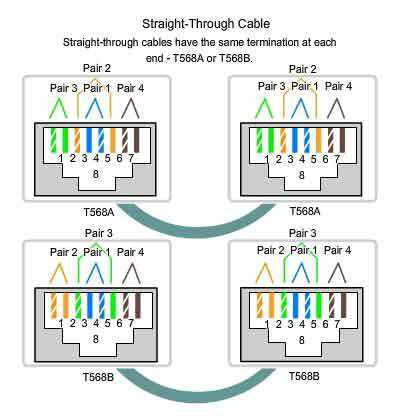From Wikipedia, emphasis mine:
Cables terminated in registered jack connectors used in building wiring and the telephone network normally consist of twisted pairs of wires. Wiring conventions were designed to take full advantage of the physical compatibility, thereby ensuring that using a smaller plug in a larger socket would pick up complete pairs, not a (relatively useless) two half pairs. But here again, there has been a problem.
The original concept was that the centre two pins would be one pair, the next two out the second pair, and so on until the outer pins of an eight-pin connector would be the fourth twisted pair. Additionally, signal shielding was optimized by alternating the live (hot) and earthy (ground) pins of each pair. This standard for the eight-pin connector is the USOC-defined pinout, but the outermost pair are then too far apart to meet the electrical requirements of high-speed LAN protocols.
Two variations known as T568A and T568B overcome this by using adjacent pairs of the outer four pins for the third and fourth pairs. [...]
So, the center pins 4 and 5, and their neighbours 3 and 6, follow the original conventions. But pins 2 and 7, and 1 and 8, could not follow that conventions due to electrical requirements. Hence the other two pairs are wired to pins 1 and 2, and 7 and 8.
Also note that keeping twisted pairs together is important to limit crosstalk. And different pairs have different twist rates, so maybe interchanging pairs (like using brown for blue, and blue for brown, on both sides of the cabling) affects electrical characteristics too; I'd stick to the standard colour scheme.

not sure details off hand, but this diagram will help http://i.imgur.com/UmdbtAc.png notice that there's 2 sides.. and it's not necessarily green that is separated, it can be orange, depending on whether 568A or 568B
– barlop – 2015-10-04T10:24:39.437and these two may help http://www.highteck.net/images/266-LAN-RJ-45-cross-connection.jpg and http://www.highteck.net/images/265-LAN-RJ-45-connectors2.jpg (Note that if 2 computes speak they need a crossover) (logic being, imagine two people, face them same direction or away from each other, say left hand is transmit , they can't join left hands otherwise both try to transmit on the same wire. One person's transmit needs to be connected to the other's receive).
– barlop – 2015-10-04T10:33:54.160I notice also that whether T568a or T568B it's the third from the left and right that are separated. – barlop – 2015-10-04T10:41:06.057
@barlop maybe there is no particular reason, but that is unacceptable from a engineering point of view. – daltonfury42 – 2015-10-04T12:43:41.557
The colour coding for each wire is for easy identification. Here are some excellent articles: Juniper , Crossover and Straight through Pinouts , Connector and Cable Specifications
– Nikhil_CV – 2015-10-04T13:14:29.357@daltonfury42 no particular reason for what? what is unacceptable from an engineering point of view. – barlop – 2015-10-04T13:21:09.937
@Nikhil_CV nobody suggested colour coding was for anything else other than easy identification, and nobody suggested messing up pin numbers. – barlop – 2015-10-04T13:21:44.270
@barlop reason for why pairs are arraigned in that particular order. Why pair 2's each line is on each side of pair 1. – daltonfury42 – 2015-10-04T13:25:52.197
this pic may also be of interest.. e.g. 568B crossover http://www.archonmagnus.com/mods/crossOverCable/crossOverCableDiagram2.jpg or a pic of 568A crossover. It may be that 568B and 568A are related in that one is the other one crossed over.
– barlop – 2015-10-04T13:35:46.953@Nikhil_CV, I'm not sure what you're trying to say with "There is no problem in messing up colour codes unless you mess up pin numbers", but note that the different colours also have different twist rates. So, say, switching the blue pair and the green pair (on both sides) might result in worse quality? – Arjan – 2015-10-04T14:47:19.860
@Arjan he's not very clear but maybe he's just making the obvious statement that if you label Wire1 to be pink, and wire 2 to be indigo, vs whether you label Wire 1 to be indigo and wire2 to be pink, doesn't matter, as long as you know your colour code, and he's saying as long as you don't mix up wire1 and wire2. That might be all he's saying. That's how you can "mess up" colour codes without messing up pins/wires. – barlop – 2015-10-04T16:19:01.510
I notice if you put the wires in logical order - each pair side-by-side to minimize crosstalk - this will split the transmit and receive signals between pairs, increasing crosstalk. However, if both the jack AND the plug could be wired with all pairs in order, this should cause less crosstalk than conventional, as long as only these custom cables get used. – Chris Jenks – 2019-09-15T15:25:23.020